Up in the Balcony
In 1937 the Rialto theater in Stromsburg underwent a major remodel which was covered in the paper and warranted its new title: "The New Rialto." Recent work in that building, which is now the Legion Post 132 hall, uncovered a sign with those exact words and it is now displayed above the serving window. The paper described ornate indirect lighting in wall fixtures which still exhibit their theater-like style today. There was also a balcony, which the writer was able to visit only recently.
It seems that the Legion makes available mobility devices such as wheelchairs, walkers, bedrails etc. to people in the community who need them. It so happened that one such person was my wife, Eleanor. So I found myself following the Legion Commander up the narrow steps to the old Rialto balcony where some of the mobility items are stored. It should be said right now that these things came in mighty handy and were much appreciated.
The paper went on to describe the stage which is where the kitchen now is, complete with red velvet curtains. Was this the stage where Johnny Carson once appeared? Stanton Moore described this visit in his interview on CD which can be seen at the library. The balcony is now hidden by the ceiling of the hall, as is the metal-lined projection room three steps further up. We even saw the two carbon-arc spotlights that illuminated the stage from on high.
There is something about a balcony that attracts youngsters like a magnet. No doubt many people who were around in those days remember some balcony adventures. It was fun to see, even though it took a broken limb to make it happen.
-Dalakarl
................................
Melgrens
He said he was from "south of Topeka, Kansas." A glance at the map showed that that Osage City and Stotler, Kansas, were in this area. Two little known places, except for Swedish Mission people. Now we had more questions to ask our "new man".
But slowly the memory bank started to work. Rev. C.P. Mellgren was one of the first ministers around 1868 at Princeton, Illinois, Mission church, the site of our internship in 1968-9. We had followed his career to Kansas with a group of Princeton people to...you guessed it; Osage City and Stotler. Now we REALLY had some questions for the younger Melgren.
Yes, he could confirm it, C.P. Mellgren was his great-grandfather. Don't you love it when a plan comes together? We couldn't wait to show him a picture of his great-grandfather from a book about the Sunnerbo Mission Society in Sweden, one he had never seen.
There's even more. His mother's family from Chicago's North Park area included Aunt Arlene of the college administrative staff. Did we know her? Oh, yes, she attended Immanuel church as did we, and led a memorable tour of denominational leader's homes around North Park we enjoyed a few years back...including President Bjork's. Her father, Justin, preached in Swedish at Immanuel once a month back in the 1960s. "He's my grandfather," exclaimed Melgren. Oh my.
The whole Melgren clan gathers at Christmas in the old rural Osage City neighborhood. He said they have all the Christmas dishes; ostakaka, potato sausage, and even including lutefisk. What a delight!
-Dalakarl
.........................
On the Back Track
A Saunders county fellow was fortunate to have a great-great grandfather who set out with some friends to get in on a gold find at Pikes Peak, Colorado. Some rich nuggets and even richer stories were circulating along the western edge of "the United States" in 1859, which at that time was marked by the Missouri, a fact that seems strange today. J.T. Gibson and his Iowa colleagues hailed from Marengo, Iowa, which was also the home of the Stromsburg Scott family.
They were scarcely a day into Nebraska Territory when they met "some teams" headed the other way in discouragement. Still the Iowans believed they were made of "sterner stuff" and continued on. The next day they met 43 back-trackers, but may have been distracted by the huge plains state thunderstorm of the kind never seen back east. They continued on.
When 350 teams were met back-tracking by 11:00 o'clock the next morning, the boys gave up. But they did not back track. Instead they revised their destination to...California, which they reached by autumn! They were made of "sterner stuff" indeed. Gibson's log records overnights near present day Swedeburg and David City. They reached the Platte and would have traversed the northern boundary of our county as well.
No gold was ever found, but employment at $3 a day kept body and soul together for the determined Iowans. In an earlier column we wrote of Scandinavians enlisted by Mormon missionaries to cross the continent to their Zion in Utah. The Danish colony of Blair, Nebraska, is said to have been largely populated by "back-trackers" of that stripe.
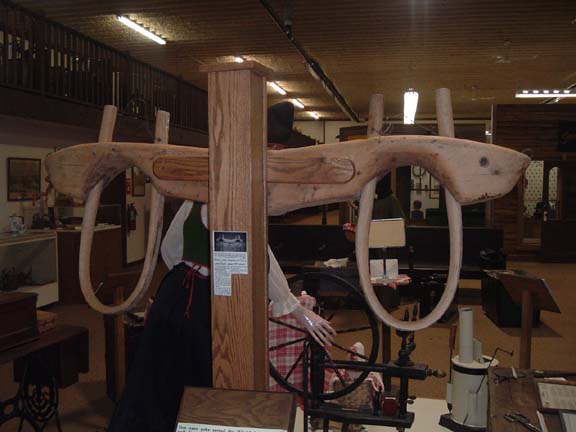
The museum in Holdrege displays an ox yoke employed by a couple on the return from Salt Lake. It has special interest since it was donated by neighbors of Eleanor's folks. In another angle, by the 1930s there were more Swedes returning to Sweden than there were immigrants coming this way. That came as a surprise. It's back-tracking any way you look at it.
-Dalakarl
................................
A Letter to Sweden
I recently had occasion to mail a letter to Sweden. While doing so, I made the comment to the post office lady that perhaps at one time there were many letters sent from Stromsburg to Sweden. Her answer startled me. "There still are," she said. Since she knew from memory what the postage amount would be, $1.20, the fact was confirmed. At one time a single stamp was available in this amount. Evidently there are still quite a few keeping in touch with relatives of ancestors across the Atlantic.
My letter was in response to a man named Strand who was a relative of the Peter Bergman family of Polk County. His query had made its way from the courthouse to our genealogy group. He mentions that Peter came to Polk County at 20 years of age in 1867, married Mary Moberg in 1871 and had relatives named Grym who also lived here. Among the Grym's eight children were Olof, Nils, Joseph born 1882, Ester 1883, Bertina 1885, Artur 1887, Ellen 1890 and Joseph 1895. Some may have taken the last name "Hall."
By fortunate chance the obituary of Mrs. Bergman appeared in the 1938 newspaper on my desk, and from that a reference to Peter's passing a decade or so earlier. They are buried at the Swede Plain cemetery, and a look at an old plat book shows one of their farms just north of there on the same section.
Strand's interest in Bergman centered on his patented water pump and the business which he built up installing it on windmills around Polk County. When he died his estate ran into six figures, being administered by Nils Nyberg and coming as welcome relief to empoverished Swedish relatives. When his widow died she lived in Polk and belonged to the Swedish Mission church there. The administrator of the Holdrege orphanage attended her funeral; an indication of the Bergmans' generousity.
Since then, the name Bergman has found new interest for me whenever it appears. A letter from an old friend who had moved away was printed in a 1908 paper. He reported that Peter Bergman had brought him out to his farm while he was back visiting, and showed him his latest planned invention. Believe it or not, that invention was for an airship! Then, while looking for something else at the county clerk's office, Bergman's name appeared several times. In the 1880s and 90s he was buying and selling, or perhaps financing, multiple properties in the town of Stromsburg!
With curiousity fully aroused, we now wait for more information about another early resident.
-Dalakarl
.............................
Yesterday and Today Shaking Hands
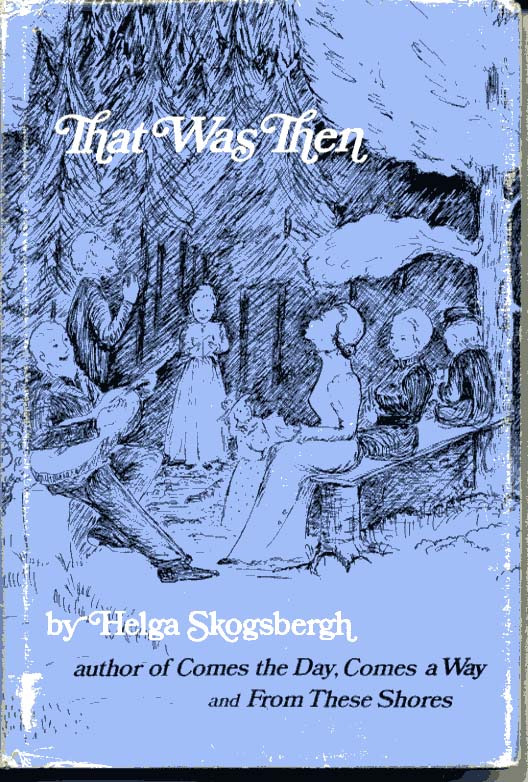
As she walks past the sites and remains of her school, church, businesses and the warf extending into the lake, a flood of memories come back. There is a vivid scene in which she relights a kerosene lamp, places it in the broken window of the abandoned house which once was her home, and goes out into the woods to look back and imagine the years melting away. The burial site of a sister lost in childhood and laid to rest by family and friends in a woodland clearing has nearly disappeared...a highway now runs disturbingly near to the site.
All told with skill and feeling, culminating in the phrase, "yesterday and today were shaking hands." I really like that...tak ska du har, Helga...thank you. But there is some more to the story. Another lady in Nebraska, whose name is Hammerstrom came across a reference on the Dalakarl.com website to one of her ancestors and wrote me about it. We were able to supply more about that relative, but when the Hammerstrom name appeared in connection with our home of Wausa, it prompted me to pass that along to her as well. Sure enough, that was one of her relatives, too.
Now, as Ingrid is remembering her childhood neighbors, the names Hanson and Hammerstrom are mentioned. Time to email my Nebraska friend again. Soon an answer came back: she was so taken by the reference and page from "That was Then" that I had sent her that she went online and found her own copy of the book! Were these also relatives? Don't know yet. Was Helga related to Rev. E.A. Skogsbergh? Don't know that either. More discoveries lead to more questions, as "yesterday and today shake hands."
-Dalakarl
.........................
Chaos in the Cowbarn
A farmer named John Proud and his wife were busy doing what nearly all farmers did twice a day: milking the cows. Because it was seven days a week, 365 days a year, milking the cows was tedious and boring but it did build up the muscles in the lower arm. No, there were no milking machines in those days, at least not on small farms. As an aside, many were the letters from immigrants back to the old country which remarked that in America, men actually milked cows, too. In Sweden it was considered women's work.
One of the diversions while milking was to take a shot at one of the cats lingering about waiting for some fresh milk. This, in my case, normally involved pouring some in an old hubcap. But another method was to squirt a stream right into the cat's mouth. This kind of thing might have been discouraged by the elders, but I saw my dad do it, too. So there were usually cats around at milking time and that sets the stage for this story.
Cows were surprisingly docile about being milked, especially the old ones. But some required a chain device hooked to their rear legs to prevent "kicking the bucket." Did you wonder where that saying originated? People now claim to have a "bucket list" but I bet they never milked a cow and so don't know what they are talking about. This device was known as "kickers." Would PETA have approved?
The cow Mrs. Proud was milking happened to put its hoof down right on the tail of one of the cats, who then sank all of its claws into the cow's leg quite understandably. Chaos ensued. The fate of the bucket went unnoticed, as bossy let loose with a kick that sent Mrs. Proud sprawling, with a broken leg!
Mr. Proud immediately came to her aid, trying to get the victim from beneath the cow, but bossy was not done. She delivered another blow which connected squarely with Mr. Proud, breaking his leg as well! "The couple lay on the ground for over an hour before their cries attracted a neighbor," concluded the article. What a way to get in the paper!
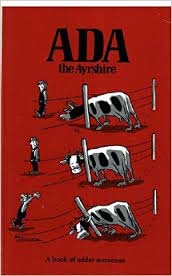
Did this story make you think of Ada, too?
-Dalakarl
........................
Swede Home Store Burns
"The insurance adjuster pronounced the building and stock a complete loss, and as it was but partly covered by insurance it will be quite a loss to the company, but all are thankful that the adjoining buildings were saved."
Chattie took advantage of the reporting to do a history of the Swede Home store and for that we owe her yet another debt of gratitude...for a Folkets Vän column. It was started in 1873 (or 1884 according to another source) by P.O. Chindgren and he held forth for many years.
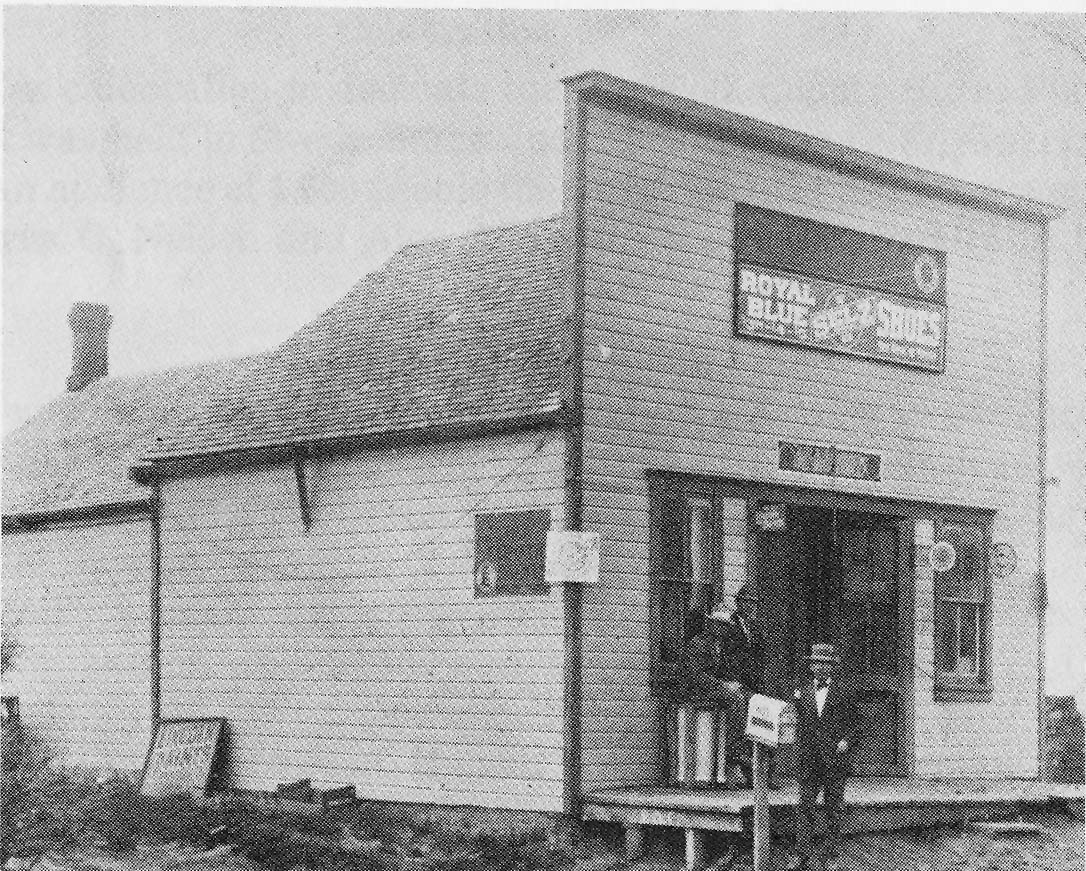
The next owners were Toline and Johnson in 1907, but they were soon succeeded by F.E. Heim and then the Branting Brothers and in 1911, F.O. Branting and son. Mostly familiar names still. Mildred Flodman's history (the gray book) has much more about the store for those interested, with some details at odds with those stated above.
As an aside, we have been reading about the language transition to English in the immigrant communities. Churches continued to use native languages into the thirties and often established summer schools so that their children, going to English-speaking public schools, would not "lose" their mother tongue. I suspect it was Chattie's English newspaper that educated the first generations of Polk county immigrants in the use of the English language as much as anything else. Think about it.
It might come as a surprise that the little store generated a reported $60,000 a year business during the Branting years. But, "...with the automobile and good roads, the day of the country store is passed, and we are told that at the present time the business was not a paying proposition, and it will not be reestablished." So ends the article.
-Dalakarl
..............................
The Birth of Highway 92

It's a bit of a puzzle who was doing the advertising. Was it the city business and civic organizations as had been the case with "good roads?" Or had the governments gotten involved with representatives from the local regions promoting them in the state houses? In this day of interstate highways, advertising of this kind seems quaint.
It appeared to cross Iowa on a straight line until reaching the Mississippi, where it jogged up to Muscatine. Then near Mendota, Illinois, it joined up with #34 to run northeast into Chicago as Ogden Avenue. Highways #30, #20, and #12 all entered Chicago after traversing the midwest! The same could be said of #92/34 and #6. Speaking of #30, the reigning king of highways, it appeared on the map as a very "jiggly" line (all those 90 degree turns...not "built for modern vehicles").
Did #92 live up to its billing? Part of the answer might be the now-forgotten towns along its route: Lewis, Massena, Delta, Washington or Cotter. It did reach Winterset, of the covered bridges, Oskaloosa and Muscatine but Des Moines and Iowa City remained on the "old" road. I drove both #20 and #30 from Nebraska to Chicago before I-80 made it so much quicker, but didn't even know you could get there on #92. Here in Polk county we still like #92 as a route to Omaha, especially now that Wahoo has that bypass...
-Dalakarl
..........................
Aviation Update
This subject may seem out of place here, but remember that Charles A. Lindbergh was indeed a Swede and one of whom his countrymen were very proud. In fact, at the North Park Archives there is displayed a bust of "the Lone Eagle" right next to Jenny Lind.
And so we intend to bring some of the local aviation events up to date. First, the report by one elderly lady that she had taken a ride in a Ford Trimotor from a local pasture was met with skepticism by me. Lo, and behold, the newspaper reported that indeed, a Ford Trimotor had landed locally and was taking passengers for a flight around the town! While it was the leading airliner of its day, it was also capable of landing in a reasonably level pasture, which is why most of them found their way to South America in their final years of service.

Lind Brothers with Stream's Aeronca Champ
In the post-Lindbergh enthusiasm for flight, one Craven Stream advertised an airstrip on his farm southeast of Stromsburg. While Ström is a common Swedish name, his is the only example I know of which was anglicized to Stream, the literal meaning of Ström. There had already been "barnstorming" visits to pastures north and west of town, and more formalized airstrips south and, most recently, east. You didn't think barnstorming originated with football, did you?
What prompted this subject was a remarkable ride in the back seat of a new friend, who, not knowing his passenger was aviation-minded, volunteered that as a youngster he had been very interested in airplanes. He went on that he once had a "small plane." I was thinking of the model airplane variety when he startled me with the remark, "it only had forty horsepower." That would take it out of the model realm and into the early days of private flying when Mr. Piper's Cub and Mr. Taylor's Taylorcraft flew with forty horsepower engines.
It was the latter that my friend had learned to fly in, right down the road in York. For fifteen dollars one could take an hour's lesson in one, and since he could make sixteen in a week delivering groceries, the course was clear. He hitchhiked to York and "slipped the surly bonds of earth" as pilots like to say. Only then could I gather up my wits and tell him that I also was a birdman, but behind a whopping fifty horsepower Aeronca!
And on the aviation theme, there was an even earlier example in the case of Peter Bergman. When a friend returned to Stromsburg for a visit, Peter showed him his plans to build an "airship," no doubt building on his experience of aerodynamnics in the windmill business. That was in 1909, as I recall.
-Dalakarl
...........................
Peter Bergman, Capitalist
Since last writing about Peter Bergman, the holder of a windmill patent and several farms in northwest Polk county, his relative in Sweden has sent more information and pictures. Bergman, standing by a mid-twenties Buick, resembles Mark Twain in appearance. The picture was marked "Platte farm," one of several he had in the Platte precinct over the line from Pleasant Home precinct.
Again, some of our best pictures of early Polk county come to us from Sweden! Among other details of his estate were loans he had made to others. Apparently he was one of those individuals who operated a bank out of his vest pocket. We returned pictures of his burial site and maps showing his farms to the relative in Sweden. Here is part of our letter to him:
Dear Mr. Strand
The material you have sent concerning Peter Bergman has opened the door to many interesting conversations here in Polk county Nebraska. As always, the more we learn the more questions we have to ask.
I mentioned last time that it was surprising to find his name on so many properties in the town of Stromsburg. Then a new discovery: looking at the maps (attached) of Pleasant Home Precinct and Platte Precinct of western Polk county from 1906 I find well over a thousand acres of farmland in his name. By rough estimate this would equal 10-12 million dollars today.
No wonder that in the 1900 census, he reports his occupation as "capitalist." (also attached) Land values were increasing rapidly here in his time. This makes me think his wealth was primarily from shrewd land investments. The accounts you sent indicate also he was lending money to others and receiving interest and principal repayments.
The pictures you sent were great. I suspect the building at the left edge of the picture is the cabin mentioned. There appears to be snow on the bushes (?) behind the ladies, who are dressed for Nebraska winter.
I am curious about other charities he might have remembered in his will. We have read he contributed to the Swedish Mission Hospital in Omaha Nebraska, and suspect he supported the Swedish Mission Orphanage in Holdrege, Nebraska. Other relatives here in US we have not yet found.
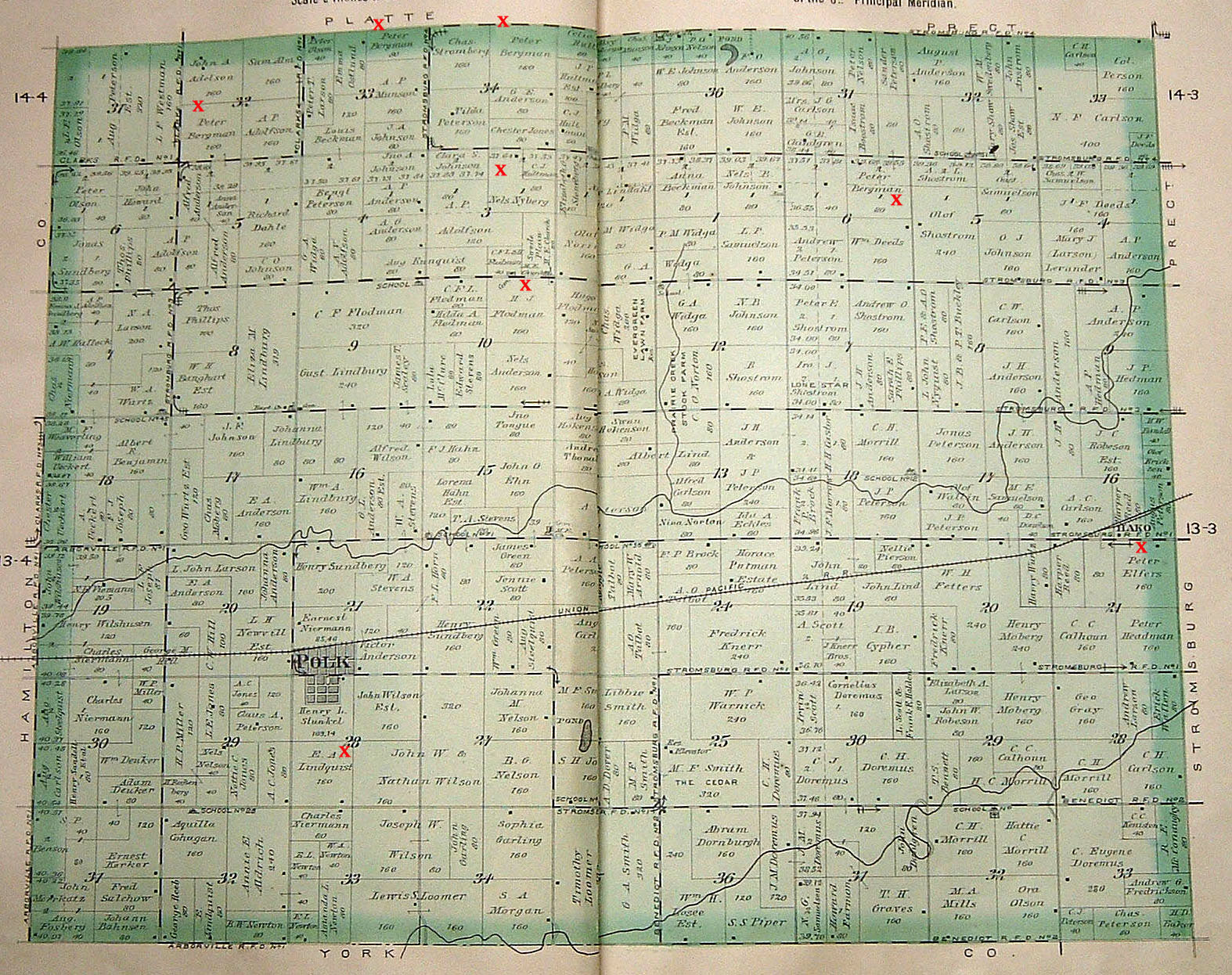
On the maps, beside his farms I have marked the location where he is buried: Swede Plain church just above the Floodman farm. Also the Nels Nyberg farm which is still in the Nyberg family. Do you know how they might have been related? In the lower part of Pleasant Home Precinct I have marked my relative's locations: Lindberg farm now owned by Rodines, my grandmother's family and "Haku" (a word meaning a Pawnee Indian festival) which soon was renamed Durant where my Grandfather managed the grain elevator for quite a few years. In the Platte Precinct I placed a "G" by Swede Home cemetery where two of my great-great grandparents are buried, and the Fredrickson farm where some of them lived. So you see, I have many connections here. In the wonderful Swedish way of designating ancestors, these would be: "farmors farfar and farmors mormor." I hope I have this right. Stromsburg is not on these maps but is close on the right.
-Dalakarl
..............................
Anna Bloom
This morning I ventured out to the cemetery to find the grave of Anna Bloom, who died in 1954. She is listed in the book, Polk County Heritage, in the very valuable cemetery section covering the burials throughout Polk county. She is also listed on the new Stromsburg Cemetery directory which is highly spoken of by visitors. But to find out who her husband was, it was necessary to locate the actual grave, and brush aside a few leaves. There was the marker for Gust Bloom; 1853 - 1923.
Why, you may ask, this interest in Anna Bloom? It turns out that in the later part of her 31 year widowhood she found employment as the housekeeper for great uncle Eric Forslund, himself a widower. In 1940 she sold her house to Harlan and Helen Fusby and became one of a long series of people to occupy a room in the Forslund house at 10th and Highway 81. As the future of this house becomes more and more doubtful, it is interesting to make a list of its occupants in the 25 or so years Forslunds were there.
First of all, Eric's father Johan was guest in their home till his death in 1902. That would have been before their living on 10th street; probably either in the Polk years or at the farm of the Engstroms...a timeline remains to be done. But Eric's wife Emma was host to her father Carl Johnson for many years till his death in his upper nineties. He served as "grounds keeper" at the 10th street location as well as keeper of the livestock. Originally it was the only house on the block, and had a barn.
Prior to their marriages, Forslund daughters Lillie and Sigrid would have called this house their home. Lillie married Hartwig Flodman and Sigrid married Delbert Query (who Lottie Johnson recently told me, was first cousin to her father!!). There were many family gatherings at this house after the girls were married, and most often included Emma's cousins Eric and Claus Carlson who lived here then. Claus's son Robert remembers visiting grandpa Carl's room upstairs for "refreshments."
While Eric was alone in the house after Emma's passing, a most unlikely scheme was unveiled in the paper. The Gust Granbergs were contemplating moving in with Eric, presumeably to share costs of what was a rather large house for one. My suspicion is that this notion was conjured up by the husbands and vetoed by the wives, since it never saw the light of day.
But Anna Bloom did become a resident there, and the family events recorded in the thirties and forties always include her in attendance. She had become "one of the family" and yet another occupant of the house at 10th and Main.
postscript: a later want ad in the paper shows "how times have changed."
WANTED: An old lady to keep house, by an elderly gentleman. Inquire at Headlight office.
-Dalakarl
...............................
Letters from Sweden
Lately different folks have entrusted me with the task of translating, insofar as I am able, letters from relatives in Sweden. There is something remarkable about the similarities in the few seen so far, which may be only a coincidence but time will tell.
The British say "to your health" as a greeting, and in Swedish "Hälsningar" serves that purpose in the same fashion. There will be many "hälsnings" in the Swedish letters seen so far, one for each American relative that comes to the writer's mind...sometimes as a postscript.
Then the epistle really gains traction should there be a death in the family to report. What it is about the nordic instinct, or should we say the "old world" instinct since it certainly crosses national boundaries, that relishes the morbid task of detailing the last days and hours of someone who has passed on? Count on a generous part of a letter from the old country to be devoted to this subject. From the fatal morning, when uncle got up as usual for his coffee, till the last shovel of dirt is thrown on the grave, no detail is missed. Having reached this climax of drama, the subject then typically turns to the weather, as all letters must.
Finally another noteable characteristic shows itself. Profound apologies for the shortcomings of every part of the letter just read, from the penmanship to the disorganized composition all reflecting the deficiency of the writer, must be made. This self-effacing is also typical. More than once, the writer urges the recipient to find someone there in America to help with deciphering the "scratchings."
-Dalakarl
................................
Selma Jacobson
Lately I have been inspired by the story of a little lady named Selma Jacobson. This would not have been an uncommon name; maybe you have known someone with this name and very possibly I have too. But this Selma Jacobson made a name for herself in the Swedish community of Chicago and North Park. She would have even been present there in the years I was there also, but sadly our paths never crossed.
Selma grew up in the parsonage of a south Chicago Augustana church and so was grounded firmly in the immigrant community's lore. It was in her adult years that she became infected with a special interest in her heritage and history, something that readers may identify with and the writer...certainly so. Selma became known for this interest of hers, and soon had acquired a collection of books and other items of the heritage.
Seeing that much along these lines was being lost, she intentionally worked to organize interest in preservation. Soon her apartment was overflowing. She began looking for space, and found a sympathetic ear in North Park's President, Karl Olsson. He made available a room in one of the buildings on campus as a place for Selma to store and continue to organize the collection.
Then came a windfall. There was a store called Dalkulla in Chicago which had long featured Swedish items and even was ticket agent for steamships bound for the old country. As much can be gathered from advertisements in the store windows which can be seen in pictures. But the age of the immigrants was passing, and Dalkulla's proprieter was going to retire. He knew of Selma, and offered her the entire remaining contents of his store!
Thrilled, but operating with a deadline and having already filled the North Park room, Selma evicted her car from its garage and proceeded to transport carload after carload of the Dalkulla windfall to her own garage. She did this by and large by herself. The piles of boxes can be seen in a picture preserved in her story. Again North Park came to the rescue, and I seem to remember a basement area of Nyvall Hall Seminary which was being used for "storage."
At last, in the building of the new Brandel Library, there was space dedicated to the Archives and home to the Swedish Historical Society of which Selma was a pillar. It is a wonderful place that I love to visit; if only it were closer...but they have a very good website. Only one thing might be regrettable; instead of calling this area the "F. M. Johnson Archives," they might well have called it the "Selma Jacobson Archives," don't you think?
-Dalakarl
............................
The Flying Parson
Someone recently told me of a three-station Methodist circuit in the Nebraska sandhills which had a unique arrangement for their single minister to make it to each place on Sundays. It seems remarkable that one minister should serve two or three churches at once even if they are close at hand...but distances in the sandhills are multiplied. So the arrangement was made that each church should have a landing strip beside it, and pastor would pilot a small plane from one to the other on Sunday morning!
Hats off to the ministers who shoulder this kind of responsibility. Ask Pastor Dan Spearow, who serves the Stromsburg, Benedict and Polk Methodist churches each Sunday, or my friend Bob Johnson who has substituted for him. At least they are within driving distance, but be sure there is enough gas in the tank (inside joke).
All this got me to thinking back to my very earliest memories of church services. I wonder if anyone else had the impression that the minister behind the pulpit, up in front, was God? That was my earliest notion, long buried beneath the corrections of Sunday School teachers and all the lessons of "growing up."
Think of the impression on the preschoolers in those sandhills churches when their pastor arrived "from the sky" each Sunday! The story of Elijah and the chariot which transported him from earth would hold little novelty to them. "He was just like our Reverend!" they might well have thought.
-Dalakarl
...........................
The Dry Years
Here is that list:
1922 21.3 inches
1923 26.3
1924 21.6
1925 18.9
1926 23
1927 26
1928 22
1929 22
1930 30
1931 21
1932 22
1933 19
1934 13
1935 26
1936 10
1937 16
1938 22
1939 15
1940 12
Headstrom's analysis of these figures revealed that the first eleven years averaged 23.7 inches, the last eight, 16.8. By his calculation that would amount to 6,300 tons less water per acre in the "dry years."
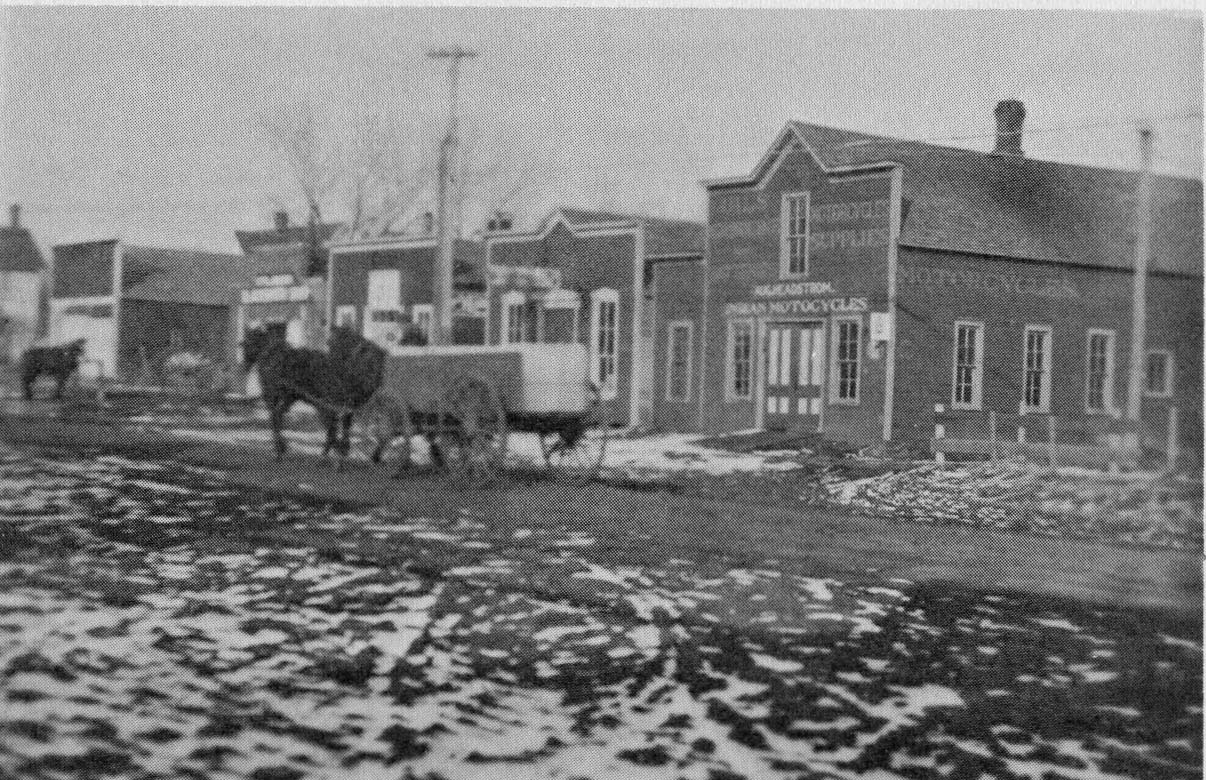
On page 178 of the 1972 "History of Stromsburg" there is a picture of Headstrom's bicycle and Indian motorcycle shop, where the Blue River Outdoor Power store is now located. We have also read that he lived as a single man in a cottage just behind his store. His name appears often in the accounts of the old Mission Church as a leading layman.
-Dalakarl
...........................
Crime Did Not Pay
In February of 1917, in the dead hour of a Sunday night, a burglary occurred in the Oschner store in Stromsburg. Then, in the gray dawn morning of the next day, a farmer near Havens witnessed a strange sight. Someone whose car (could it have been anything but a Model T?) had broken down on the road going past, and this furtive character was making trip after trip to a nearby haystack and depositing articles therein.
Suspicious, the farmer called the county sheriff who by this time had probably been alerted to the mischief in Stromsburg. Finally, most of the stolen articles were retrieved from the haystack. The car, which had been stolen from Aurora, was presumably returned to its rightful owner as well. In an earlier crime report, stolen goods once were retrieved from beneath the Morrill bridge on the Blue River.
Nebraska just does not seem to produce skillful criminals...not like, say, Illinois or New Jersey. The erstwhile burglar was not caught though, and it is unknown if he later joined "the gang that could not shoot straight."
-Dalakarl
............................